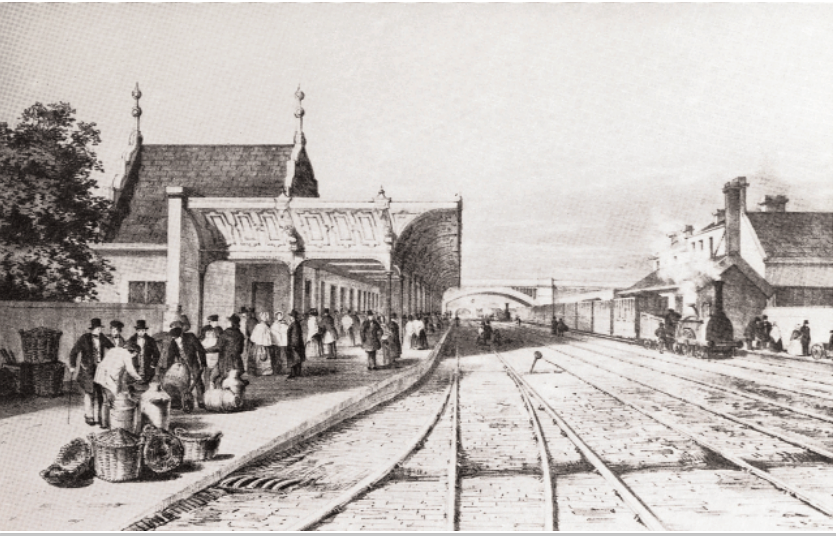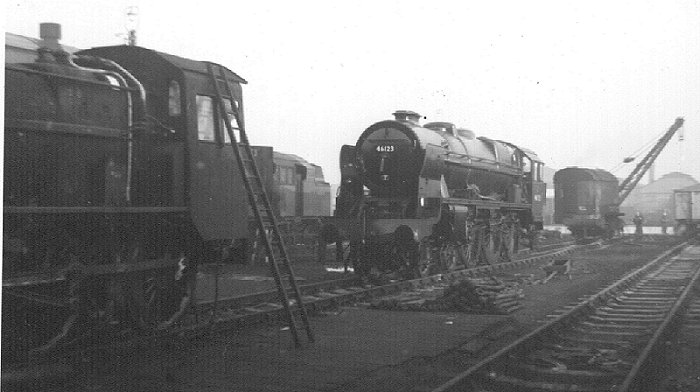|
Crewe Electric TMD
Crewe Electric TMD (officially named Crewe IEMD – International Electric Maintenance Depot) is a traction maintenance depot for AC electric and diesel-electric locomotives. It is situated to the north-west of Crewe railway station on the Crewe to Chester railway line, opposite Crewe Works. Road access is from Wistaston Road and the depot is operated by DB Cargo UK. Starting in 1987, when Railfreight introduced depot plaques on its locomotives. Locomotives allocated to Crewe IEMD carried a plaque depicting an Eagle. References Rail Atlas Great Britain & Ireland, S.K. Baker Further reading * * External links *Depot DirectorWest Coast (Internet Archive)*Aoverhead viewof the depot. Crewe Works Crewe Works is a British railway engineering facility located in the town of Crewe, Cheshire. The works, which was originally opened by the Grand Junction Railway in 1840, employed around 7,000 to 8,000 workers at its peak. In the 1980s, a lo ... is the long, rectangular buildin ... [...More Info...] [...Related Items...] OR: [Wikipedia] [Google] [Baidu] |
Crewe
Crewe () is a railway town and civil parish in the unitary authority of Cheshire East in Cheshire, England. The Crewe built-up area had a total population of 75,556 in 2011, which also covers parts of the adjacent civil parishes of Willaston, Shavington cum Gresty and Wistaston. Crewe is perhaps best known as a large railway junction and home to Crewe Works; for many years, it was a major railway engineering facility for manufacturing and overhauling locomotives, but now much reduced in size. From 1946 until 2002, it was also the home of Rolls-Royce motor car production. The Pyms Lane factory on the west of the town now exclusively produces Bentley motor cars. Crewe is north of London, south of Manchester city centre, and south of Liverpool city centre. History Medieval The name derives from an Old Welsh word ''criu'', meaning 'weir' or 'crossing'. The earliest record is in the Domesday Book, where it is written as ''Creu''. Modern Until the Grand Junction ... [...More Info...] [...Related Items...] OR: [Wikipedia] [Google] [Baidu] |
United Kingdom
The United Kingdom of Great Britain and Northern Ireland, commonly known as the United Kingdom (UK) or Britain, is a country in Europe, off the north-western coast of the European mainland, continental mainland. It comprises England, Scotland, Wales and Northern Ireland. The United Kingdom includes the island of Great Britain, the north-eastern part of the island of Ireland, and many List of islands of the United Kingdom, smaller islands within the British Isles. Northern Ireland shares Republic of Ireland–United Kingdom border, a land border with the Republic of Ireland; otherwise, the United Kingdom is surrounded by the Atlantic Ocean, the North Sea, the English Channel, the Celtic Sea and the Irish Sea. The total area of the United Kingdom is , with an estimated 2020 population of more than 67 million people. The United Kingdom has evolved from a series of annexations, unions and separations of constituent countries over several hundred years. The Treaty of Union between ... [...More Info...] [...Related Items...] OR: [Wikipedia] [Google] [Baidu] |
DB Cargo UK
DB Cargo UK (formerly DB Schenker Rail UK and English, Welsh & Scottish Railway (EWS)), is a British rail freight company headquartered in Doncaster, England. The company was established in early 1995 as ''North & South Railways'', successfully acquiring and merging five of the six freight companies that were sold during the privatisation of British Rail,The sixth rail freight company created during privatisation, Freightliner, was privatised through a management buyout. On 25 April 1996, the EWS brand was revealed and implemented over successive months. By the end of March 1997, it controlled 90% of the UK rail freight market, operated a fleet of 900 locomotives and 19,000 wagons, and had 7,000 employees. During the late 1990s, EWS invested heavily into rolling stock renewal, procuring a large number of British Rail Class 66 diesel locomotives, headcount was also reduced. It also acquired National Power's open-access freight operator in April 1998. During January 2001, th ... [...More Info...] [...Related Items...] OR: [Wikipedia] [Google] [Baidu] |
Diesel-electric Locomotive
A diesel locomotive is a type of railway locomotive in which the prime mover is a diesel engine. Several types of diesel locomotives have been developed, differing mainly in the means by which mechanical power is conveyed to the driving wheels. Early internal combustion locomotives and railcars used kerosene and gasoline as their fuel. Rudolf Diesel patented his first compression-ignition engine in 1898, and steady improvements to the design of diesel engines reduced their physical size and improved their power-to-weight ratios to a point where one could be mounted in a locomotive. Internal combustion engines only operate efficiently within a limited power band, and while low power gasoline engines could be coupled to mechanical transmissions, the more powerful diesel engines required the development of new forms of transmission. This is because clutches would need to be very large at these power levels and would not fit in a standard -wide locomotive frame, or wear too qu ... [...More Info...] [...Related Items...] OR: [Wikipedia] [Google] [Baidu] |
Electric Locomotive
An electric locomotive is a locomotive powered by electricity from overhead lines, a third rail or on-board energy storage such as a battery or a supercapacitor. Locomotives with on-board fuelled prime movers, such as diesel engines or gas turbines, are classed as diesel-electric or gas turbine-electric and not as electric locomotives, because the electric generator/motor combination serves only as a power transmission system. Electric locomotives benefit from the high efficiency of electric motors, often above 90% (not including the inefficiency of generating the electricity). Additional efficiency can be gained from regenerative braking, which allows kinetic energy to be recovered during braking to put power back on the line. Newer electric locomotives use AC motor-inverter drive systems that provide for regenerative braking. Electric locomotives are quiet compared to diesel locomotives since there is no engine and exhaust noise and less mechanical noise. The lack of ... [...More Info...] [...Related Items...] OR: [Wikipedia] [Google] [Baidu] |
British Rail
British Railways (BR), which from 1965 traded as British Rail, was a state-owned company that operated most of the overground rail transport in Great Britain from 1948 to 1997. It was formed from the nationalisation of the Big Four (British railway companies), Big Four British railway companies, and was privatisation of British Rail, privatised in stages between 1994 and 1997. Originally a trading brand of the Railway Executive of the British Transport Commission, it became an independent statutory corporation in January 1963, when it was formally renamed the British Railways Board. The period of nationalisation saw sweeping changes in the railway. A process of dieselisation and Railway electrification in Great Britain, electrification took place, and by 1968 steam locomotives had been entirely replaced by diesel and electric traction, except for the Vale of Rheidol Railway (a narrow-gauge railway, narrow-gauge tourist line). Passenger train, Passengers replaced freight train, ... [...More Info...] [...Related Items...] OR: [Wikipedia] [Google] [Baidu] |
London Midland Region Of British Railways
The London Midland Region (LMR) was one of the six regions created on the formation of the nationalised British Railways (BR), and initially consisted of ex-London, Midland and Scottish Railway (LMS) lines in England, Wales and Northern Ireland. The region was managed first from buildings adjacent to Euston station, and later from Stanier House in Birmingham. It existed from the creation of BR in 1948, ceased to be an operating unit in its own right in the 1980s, and was wound up at the end of 1992. Territory At its inception, the LMR's territory consisted of ex-LMS lines in England and Wales. The Mersey Railway, which had avoided being "Grouped" with the LMS in 1923, also joined the LMR. The LMR's territory principally consisted of the West Coast Main Line (WCML), the Midland Main Line (MML) south of Carlisle, and the ex-Midland Cross Country route from Bristol to Leeds. During the LMR's existence there were a number of transfers of territory to and from other regions. ... [...More Info...] [...Related Items...] OR: [Wikipedia] [Google] [Baidu] |
Traction Maintenance Depot
The motive power depot (MPD) or locomotive depot, or traction maintenance depot (TMD), is the place where locomotives are usually housed, repaired and maintained when not being used. They were originally known as "running sheds", "engine sheds" or, for short, just sheds. Facilities are provided for refuelling and replenishing water, lubricating oil and grease and, for steam engines, disposal of the ash. There are often workshops for day to day repairs and maintenance, although locomotive building and major overhauls are usually carried out in the locomotive works. (Note: In American English, the term ''depot'' is used to refer to passenger stations or goods (freight) facilities and not to vehicle maintenance facilities.) German practice The equivalent of such depots in German-speaking countries is the ''Bahnbetriebswerk'' or ''Bw'' which has similar functions, with major repairs and overhauls being carried out at '' Ausbesserungswerke''. The number of these reduced drast ... [...More Info...] [...Related Items...] OR: [Wikipedia] [Google] [Baidu] |
Crewe Railway Station
Crewe railway station is a railway station in Crewe, Cheshire, England. It opened in 1837 and is one of the most historically significant railway stations in the world.Guardian newspaper article, ''The beauty of Crewe'' (6 December 2005). Retrieval Date: 10 August 2007. Crewe station is a major junction on the and serves as a rail gateway for . It is 158 miles north of [...More Info...] [...Related Items...] OR: [Wikipedia] [Google] [Baidu] |
Crewe Works
Crewe Works is a British railway engineering facility located in the town of Crewe, Cheshire. The works, which was originally opened by the Grand Junction Railway in 1840, employed around 7,000 to 8,000 workers at its peak. In the 1980s, a lot of the engineering works were closed. Much of the site has been redeveloped but the remaining parts are owned and operated by French-owned multinational rolling stock manufacturer, Alstom SA. During the late 19th century, the London and North Western Railway used Crewe Works to produce many famous locomotives such as the Webb Jumbo class and the compounds, the Whale Experiment and Precursor classes, and the Bowen-Cooke Claughtons. In particular, Whale's 1912 superheated G1 Class developed from a locomotive introduced by Webb in 1892, lasted, in many cases until 1964, near the end of steam in 1968. After grouping, the works were taken over by London, Midland and Scottish Railway which was the successor to the LNWR. It was d ... [...More Info...] [...Related Items...] OR: [Wikipedia] [Google] [Baidu] |
Railfreight
Railfreight was a sector of British Rail responsible for all freight operations on the British network. The division was created in 1982 when BR sought to assign particular stock and management to the evolving requirements of freight traffic. History Railfreight existed as a single unit from 1982 until 1987 as the rail freight division of British Rail. In 1987 BRs freight operations were further divided according to the type of train operated and material carried; the Trainload Freight division and its sub-sectors handled unit trains of coal, metal, aggregates, oil or petroleum, LPG, petro-chemicals, and construction materials, Railfreight Distribution handled intermodal and non-unit train work, and channel tunnel freight. Activities which were not assigned to one of the new ''Trainload Freight'' or ''Railfreight Distribution'' sub-sectors were then continued under the Railfreight General banner, Railfreight General was dissolved in 1989, its limited responsibilities being ... [...More Info...] [...Related Items...] OR: [Wikipedia] [Google] [Baidu] |





.jpg)



